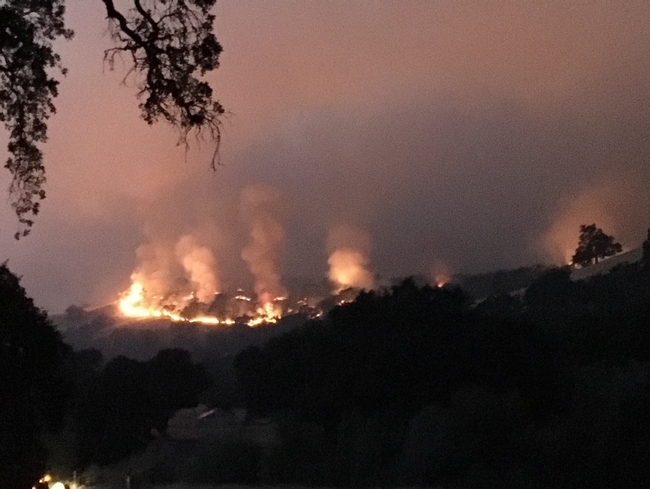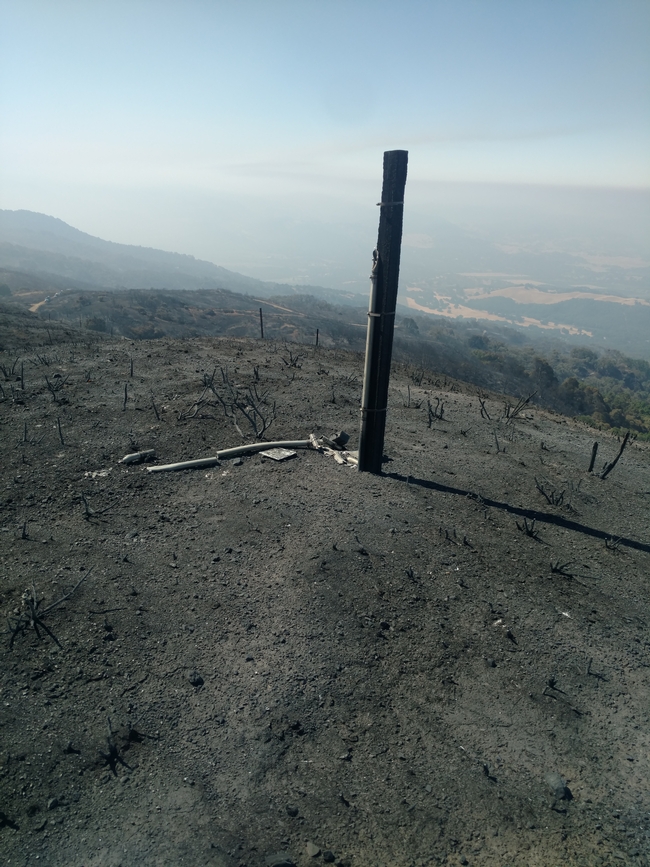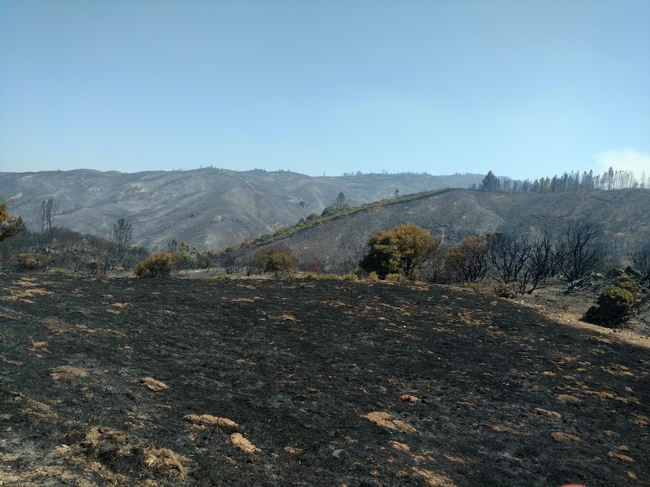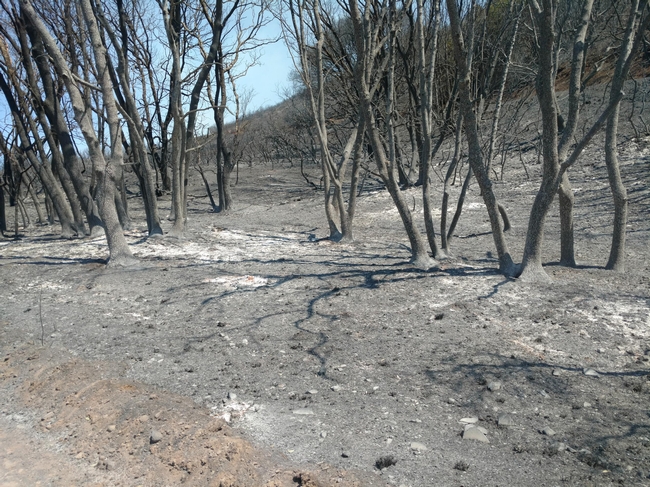
Posts Tagged: Mendocino
Press Release: Cannabis and utilities hold potential for economic development, says UCCE specialist
CONTACT: Pam Kan-Rice, (510) 206-3476, pam.kanrice@ucanr.edu
Cannabis and utilities hold potential for economic development, says UCCE specialist
As California strives to recover from the pandemic-induced economic slump, Keith Taylor is taking an unconventional approach to economic development. In the world's sixth biggest economy, where do you start? Taylor, who was hired in 2017 as UC Cooperative Extension's sole specialist in community economic development, started by tackling a couple of the state's thorniest sectors: cannabis and utilities.
Participatory research in Mendocino County
In 2016, the passage of Prop. 64 legalizing recreational cannabis ushered in an era of both opportunity and headaches for Mendocino County growers. The county's permitting program has been the source of significant confusion and debate: Between 800 and 1,100 growers have received county permits, but many have not been able to obtain permanent state licenses because of a lack of clarity around the county process and compliance with the California Environmental Quality Act. The burden of uncertainty is one reason why only a fraction of Mendocino growers have pursued licenses, says Taylor, who is based in the Department of Human & Community Development at UC Davis.
While these regulatory battles play out, Taylor says better economic coordination between small growers could buffer them against large capital interests moving into cannabis. Virginia-based Altria, the parent company of Philip Morris USA, is investing in cannabis and filing patents for cannabis-specific vaporizers. Individual legacy growers have the crop experience and market share, Taylor says, but don't have shared institutions through which they can exercise collective power — especially down the value chain in processing, distribution and consumer technology. Taylor believes that creating a small farmer-centric system will involve the creation of more interest groups, associations or cooperatives.
"For too long in agricultural and rural communities, we've encouraged people to do things alone," Taylor said in an October 2020presentation to the UC Davis Cannabis and Hemp Research Forums. However, if you look at parts of the world where rural economies do very well, they work together."
With help from a Cannabis and Hemp Research Center grant, Taylor has been working on a wide-ranging participatory action research project in Mendocino County. Taylor's team — comprised of two faculty members, one post-doctoral researcher, and two student researchers — is producing research publications, policy recommendations and public events about ways that the emerging cannabis industry can support high-quality livelihoods and environments for county residents.
"The more we make folks aware of these good actors, the more likely we are to get challenges to the incumbents in terms of climate mitigation and economic developments," Taylor said.
West Business Development Center, Economic Development & Financing Corporation and Mendocino County Supervisor John Haschak have been allies in the process so far. Haschak says Taylor brings valuable knowledge, resources and networks to bear on local challenges.
"There's a lot of opportunity for doing this whole new industry in a new way, and I think that's what Dr. Taylor sees too," Haschak said. "There's a lot of potential here for structuring the industry along the lines of what our community values already are."
As Taylor's team releases their findings, they intend to host forums at the Hopland Research and Extension Center to help the county harness the legal cannabis sector for economic impact.
Power to the people
Shortly after arriving at UC Davis from Illinois, Taylorpublished a book about the benefits of community ownership of wind energy in the Midwest. The turmoil surrounding California's largest utility, Pacific Gas & Electric, could have been ripped from the pages of his research. PG&E equipment hasignited half of California's most destructive fires since 2015, and experts pin much of the blame on the company's lack of investment in the grid.
In the months following the 2018 Camp Fire, which burned an area roughly the size of Chicago andkilled85 people, Taylor was one of the first advocates to propose converting PG&E into a user-owned nonprofit cooperative. This conversion would remove the extractive role of investors and give customers a voice in big-picture decisions about the company, Taylorwrote in an op-ed pushing the idea of customer ownership in The Mercury News in February 2019. By December, more than 100 elected officials across 10 countiesendorsed the idea. The federal bankruptcy judge overseeing PG&E's case did not endorse the plan, although it's still possible for the state totake over the company under certain conditions. Other attempts to gain local control of PG&E's grid — including San Francisco's bid tobuy the city's power lines from the company — also stalled.
Taylor isn't discouraged. He is working closely with theGolden State Power Cooperative, an association of the state's three community-owned electric utility co-ops, to push forward what he calls a "Rural Electrification Act for California broadband." Taylor often references this New Deal-era law that gave federal loans to rural communities seeking to expand the electrical grid to their area. The act gave rise to the nation's more than 900 electric cooperatives today, including the three in California. With their help, Taylor sees opportunity in legislation or programs that would catalyze community-initiated, community-owned internet services. Plumas-Sierra Rural Electric Cooperative is already bringing broadband to the rough terrain of its mountain customers.
"When you first set foot in California and are exposed to the giant that is PG&E and their influence over policy, you think that it's an obstacle that's too difficult to overcome," Taylor said. He tries to elevate the visibility of people who are making inroads and recently featured Kevin Short in a webinar about community economic-development innovations.
Short is the general manager of Anza Electric Cooperative in California's high desert and current board president of theGolden State Power Cooperative. He said there are "tremendous opportunities" in the idea of growing cooperative broadband entities, especially with the attention on infrastructure at the state and federal levels. Short said the effort will take some creativity and willingness to depart from existing models: "The old saying among us here is if you've seen one co-op, you've seen one co-op, because it's going to be different everywhere you go."
In both of these areas — cannabis and utilities — Taylor says his role is networker and facilitator. As the only economic development specialist at UC Agriculture and Natural Resources, he spends a lot of time researching and meeting people to understand where his efforts can be the most strategic. "In order to scale, I've got to go small, root and build and be comfortable with that process," he said.
Small works for now, but Taylor remembers an associate dean telling him, "You've got a great job, now make it work for 40 million Californians."
UC Agriculture and Natural Resources brings the power of UC to all 58 California counties. Through research and Cooperative Extension in agriculture, natural resources, nutrition, economic and youth development, our mission is to improve the lives of all Californians. Learn more at ucanr.edu and support our work at donate.ucanr.edu.
To read more UC ANR news, visit our newsroom at ?http://ucanr.edu/News.
Follow @UCANR on ?Twitter?
Like us on Facebook? https://www.facebook.com/ucanr
A Tale of Two Fires
Fire has a vitally important role in the California landscape and many fire-related studies have been conducted at the UC Hopland Research and Extension Center (HREC) since 1951. The majority of these fires have been prescribed burns, well controlled to manage invasive species and reduce fuel load, but on July 27 the staff had to deal with a very different kind of fire, as the River Fire swept across the site.
Below I share my experiences of both prescribed fire and wildfire at HREC:
Just a few short months ago, I enjoyed an afternoon with staff on site watching as CalFire conducted a prescribed burn to reduce invasive grass species and fuel load. The sight of the flames racing through the grasses was exciting and the skill of the CalFire team in controlling the fire inspired both respect and a feeling of safety – we were in good hands! The crews worked hard to protect some of the great oak trees we have on the site and to respect areas of cultural significance, including a rock inscribed with ancient petroglyphs. Tankers flew over sprinkling us with red fire retardant as they passed, allowing a new pilot some practice while keeping this burn well controlled. This burn inspired hope and in the space of just a month we were already seeing green shoots replacing the black of the burned areas, a new chance for the native grass species adapted to fire.
How different an experience last week as a wildfire, the River Fire, began to burn close to our site on the afternoon of July 27. This fire was not under control, its power and size increasing so rapidly that by the afternoon it had spread to HREC and was quickly moving through oak woodland, grassland and chaparral. I'm very lucky to be able to live and work on this beautiful site, but suddenly the oak woodlands that once held much joy for me all just looked like fuel. It was clear that the homes that we lived in were at significant risk and difficult decisions were made about what items should be loaded into the car and what we must drive away from – not knowing if we would return to find them intact.
While residents on site prepared to evacuate, other HREC staff were making decisions about the many lives that depended on them for their wellbeing, the flock of 500 sheep and their accompanying 6 guardian dogs and 1 sheepdog. Shepherd Jim Lewers was quick to consider the safest space for the flock and they were herded swiftly downhill to the flat irrigated pasture at our lowest elevations. Our wonderful neighbors on the Poor Ranch were working hard to protect their homes and to consider how they might also link with efforts to save HREC homes. As the sun set, the fire looked more daunting to all, HREC residents had left the site, but a few staff stayed on to do what they could as they waited for CalFire – who were stretched thin with numerous fires to attend to.
My last phone conversation that evening with our interim director John Bailey was worrying.“I'm not feeling confident, the fire is headed downhill towards headquarters, is there anything else you need from your house?” he asked.
Although I know of the huge benefits of fire to our lands, this fire was now encroaching on our homes and it was hard to consider any positive role it might have. At around 9 p.m., CalFire moved their incident command to HREC alongside a team of at least 3 bulldozers, a water tanker and 6 engines. It's hard to express the gratitude you feel to these men and women who will put themselves at such risk to save the homes of strangers. This was certainly a turning point for HREC, all buildings and animals were kept safe although around two-thirds of the site did burn above headquarters and spread east towards Lake County. Although the fear for headquarters could dissipate – it was with grim understanding that now others were at risk and this fire was still burning strong.
As I write this, a few days on, we are now assessing the damage to the site. Our water supply is severely affected, pipes that carried water from springs on site simply burst as the water inside them boiled due to the heat. Our team is out checking for dangerous trees, which still smoke ominously along the road. The many research projects that used our site as their “living laboratory” are impacted to various extents. And yet – we know how lucky we are. On our minds are all the people facing evacuation and the potential loss of their homes or worse. The role of HREC in sharing advice on fire safe measures alongside the Mendocino Fire Safe Council becomes stronger and clearer.
Now that the immediate fear has subsided, I can think again about the healing power that this fire will have on parts of our landscape. Many of our oaks did survive and prescribed burns over the years have aided in ensuring some parts of the site suffered only quick moving grass fires. Although the important wildlife research conducted by the UC Berkeley Brashares lab will be significantly impacted, we will now be able to see the movements of the many GPS collared deer that live on our site in relation to fire. This fire will offer many more opportunities for researchers from different fields to study post fire impacts with access to long-term pre-fire data to support their work.
Our site is here to provide answers to scientific questions associated with a Northern California working landscape – and this fire has allowed us to gain knowledge, the opportunity to learn more and the impetus to share that knowledge to help where we can.
This picture was taken on Friday night, July 27 as the fire started to move downhill towards the headquarters area.
Research projects have been affected, for example this weather station was completely destroyed by the fire. On the positive side - there are now many opportunities to see the regenerative aspects of fire and the research associated with those.
Looking across to Cow Mountain from the higher points on the site through the chaparral.
Many of our oaks have survived, past prescribed fires and grazing decreased the fuel load beneath the trees reducing the temperature and allowing fire to move through quickly. However in this are a mid story of madrone led to higher temperatures and prolonged burning which may have killed some of the black oaks to be found in the area.
Save the Date: Post Fire Recovery Workshop
See the attached flier for date, time and location of a joint agency sponsored workshop for those impacted by the recent fires.
November 15 Fire Meeting
Oak Woodland Conservation Workshop at HREC
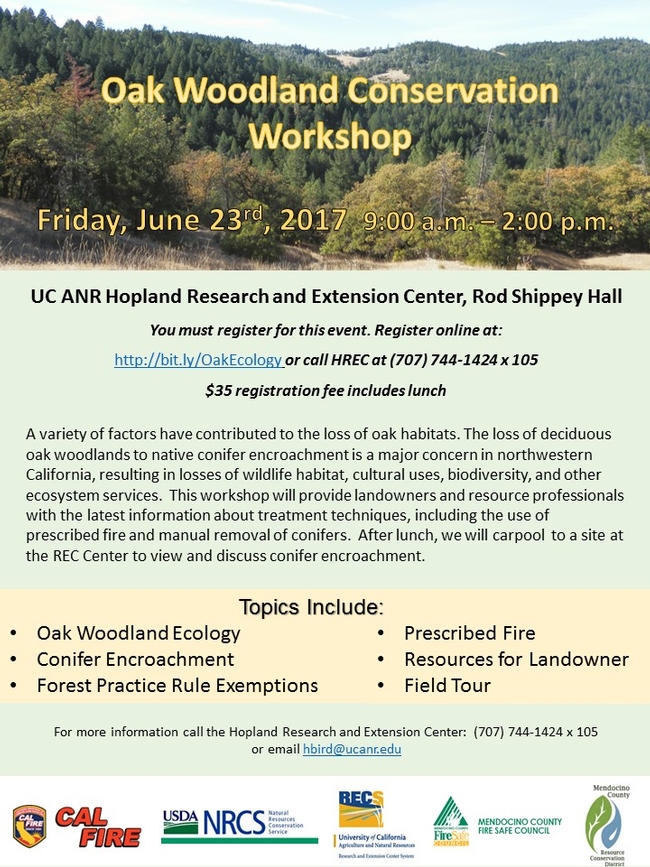
Mozilla information scientist finds her passion at UC Sheep Shearing School

“It's like a dance,” she says. “Once you have it right (and I mean, really have it), suddenly the whole method makes sense. You expend much less energy. You're controlling the sheep with your legs, which leaves your hands free, one to hold the shearing hand piece and the other to smooth out the skin so you don't nick the sheep.”
Since there are 400 ewes whose fleeces must be shorn before the hot summer months, that's important for her and her classmates.
The University of California Cooperative Extension Sheep Shearing School is the only program of its kind in California. It has been run in Mendocino County since at least 1990, but in 2009, it moved to the Hopland Research and Extension Center south of Ukiah.
Students are taught the New Zealand method of shearing, where the entire fleece is cut from the sheep as a single unit so it can be sorted and graded according to micron count. The method is designed to be comfortable for both shearer and sheep.
John Harper, UCCE natural resources advisor for Mendocino County, has been running this program for more than 20 years. Although these sheep weigh enough to make handling them a workout, he says that hip flexibility is more important than upper body strength. Since this is something women tend to have more of than men, they are often successful students.
More than 250 students from across the western U.S. as well as Canada and Mexico and have graduated from the program. Many come back year after year to practice under supervision, but also to connect with each other.
This year, a wool grading section was added to the course, taught by Ron Cole and Rodney Kott. Sheep have recently been bred much more for meat than wool in the region but there is a growing demand for high quality fleeces. The finest merino sheep do not do well in damp North Coast conditions but thrive in the dryer Central Valley and foothills, and there is a need for trained graders. Only 3 percent of California's 5 million pounds of wool is currently being processed within the state, and yet California remains a net importer of wool goods, while falling second only to Texas in sheep production. California fleeces are either composted or sent to China for processing, something another graduate of Shearing Class, Matt Gilbert, is keen to avoid.
“There used to be lots of mills in the U.S. to process our wool,” he said. “Now there are hardly any. That's why I wanted to start my own mill to process fine wool. We will be selling to handspinners and knitters and to commercial textile manufacturers. It's about trying to keep the product of this place in the region.”
Gilbert was inspired by the Fibershed movement started by Rebecca Burgess in 2010. Drawing on the locavore movement, Burgess committed to clothing herself for an entire year with textiles grown and produced within 200 miles of her house in Fairfax. The movement is gaining adherents across the country and beyond.
Wilkes says the Fibershed movement is what got her interested in learning to shear, too.
“Eight years ago, I walked into a yarn store in San Francisco and asked where the local yarn was. I knew California was a major producer of wool. I was told there wasn't any. I was curious about why, and became involved with Fibershed and attended their first symposium in October 2012. During a panel involving shearers [one of whom was Matt Gilbert], I found out that small flock owners had a hard time finding people to shear their sheep. That got me thinking that I could learn to do the work," Wilkes said.
The UC certificate really means something to ranchers and farmers. As a woman who provided a Shearing School scholarship put it recently, “When I see UC Certification, I know I'm not going to have butchered animals.”
Harper explains that the North Coast sheep herding trends have changed over time – from large producers to smaller flocks – but now there is a move back to some larger flocks, driven in part by the Vines and Ovines project established in Mendocino County by UCCE advisor Morgan Doran with help from UCCE advisor Roger Ingram of Placer and Nevada counties, UCCE advisor Stephanie Larson of Sonoma County and UCCE specialist emeritus Mel George. The sheep were subjected to aversion training so they would not eat grape leaves. Now they browse through vineyards, conducting weed control and fertilization without harming the vines. One vintner, Clay Shannon, has 1,500 ewes. He pairs premium lamb with his wines in sales to niche markets. The idea is catching on.
Meanwhile, Wilkes is shearing sheep across Northern California on weekends or before work.
“I can't express how much Shearing School means to me and to California,” she says. “There's almost no way to break into agriculture if you didn't inherit land here. I found my calling late ... I love developing open source software and working on information privacy, but shearing is my passion. Shearing School is one of the few feasible avenues into agriculture in the state.”


Wool classing.

Stephany Wilkes at the Sonoma County Fair.

